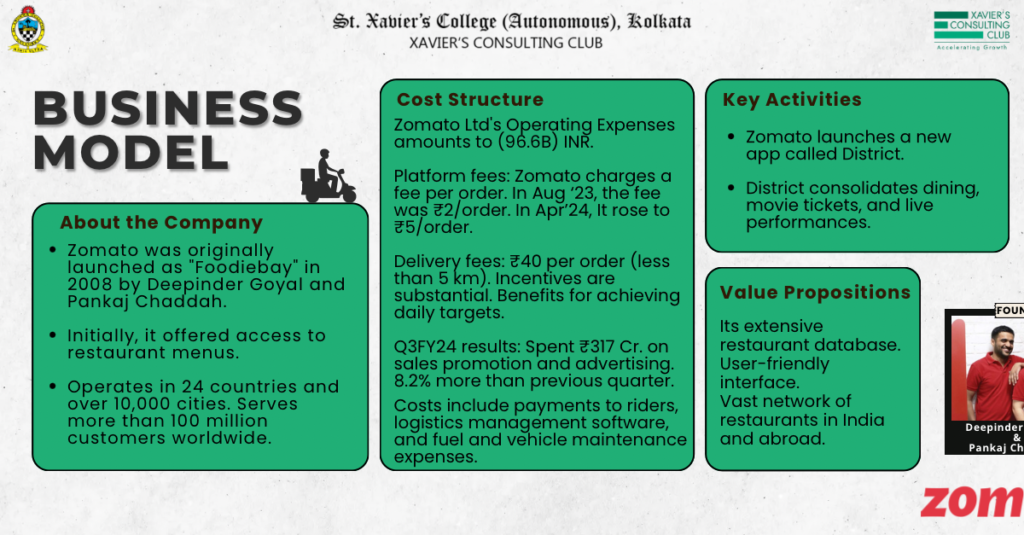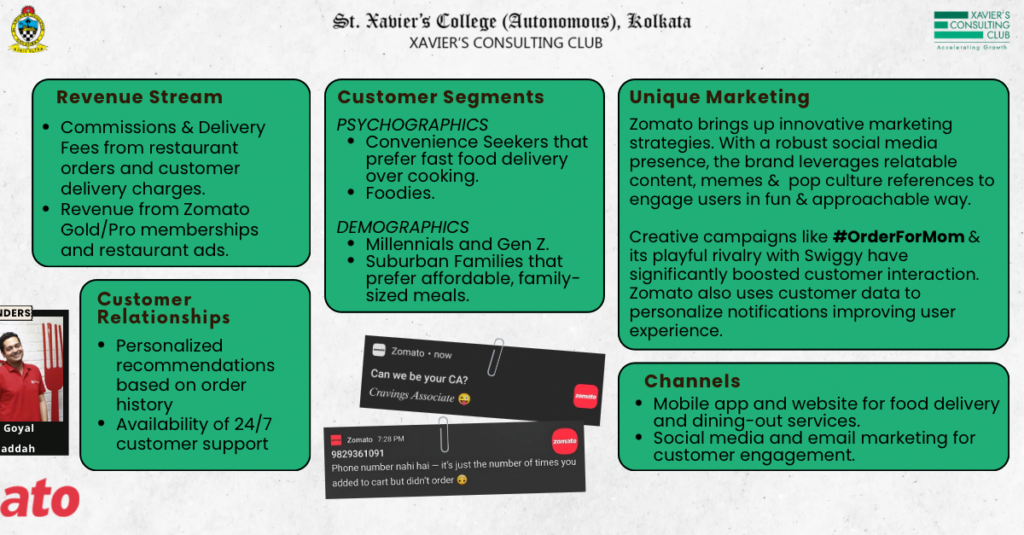

About the Company:
Zomato, originally launched as “Foodiebay” by Deepinder Goyal and Pankaj Chaddah in 2008, began as a platform offering access to restaurant menus. In 2010, it expanded into food delivery, transforming how people order meals. Today, Zomato operates in 24 countries and over 10,000 cities, serving more than 100 million customers globally. Despite fierce competition and tight profit margins, the company continues to grow. Restaurants collaborate with Zomato to list their offerings, while delivery partners manage the logistics, ensuring timely food delivery. Zomato provides users with features like real-time order tracking, discounts, and promotions, enhancing the customer experience. Beyond that, it offers valuable insights and analytics to restaurants, helping them optimize operations and improve services. Additionally, Zomato acts as a comprehensive dining guide, offering detailed information about restaurants worldwide, making it a one-stop platform for both food delivery and dining out.
COST STRUCTURE:
Based on the financial report for Mar 31, 2024, Zomato Ltd’s Operating Expenses amounts to -96.6B INR
a) Platform fees- Zomato charges a platform fee per order. In August 2023, the fee was ₹2 per order, which increased in April 2024, ₹5 per order.
b) Delivery fees- Zomato pays a base of ₹40 per delivery for orders under five kilometers, Incentives are substantial, with riders earning bonuses for reaching certain daily earnings targets. As per Zomato’s Q3FY24 results, it spent Rs 396 crore on sales promotion and advertising in Q3FY24. This marks an 8.2% increase as compared to the previous quarter which showcases the importance of advertising in order to capitalize market share. These costs include payments to riders, logistics management software, and fuel and vehicle maintenance expenses.
KEY ACTIVITIES:
Zomato operates an advertising-driven user database, aiming to connect diners with quality restaurants by providing authentic and reliable information about where to eat. Initially focused on the food industry, Zomato later introduced a subscription model to enhance food discovery and elevate the user experience.
CHANNELS:
Zomato’s main channels include its mobile app and website for food delivery and dining-out services. It also leverages social media, email marketing, and partnerships with restaurants and cloud kitchens. Additionally, Zomato uses Hyperpure for B2B supply chain operations and advertising partnerships for brand visibility.
REVENUE STREAMS:
a) Food Delivery: Think of Zomato as a digital food court. Restaurants are the stalls, and you’re the customer. Zomato takes a small cut from each order and charges you a delivery fee, just like you’d pay for takeout.
b) Dining Out: Zomato helps you find great restaurants. Restaurants pay to be featured prominently, like a good spot in the food court. Zomato Pro is like a loyalty card that gives you discounts when you dine out.
c) Advertising: Restaurants can pay Zomato to be at the top of search results or to have banners on the app. It’s like paying for a prime location in the food court.
d) Hyperpure: Imagine Zomato as a grocery store for restaurants. They supply fresh ingredients, helping restaurants save time and money.
e) Cloud Kitchens: Zomato helps restaurants set up virtual kitchens, like a food truck without wheels. They charge a fee for their services.
f) Financial Services: Zomato is starting to offer payment options and potentially loans to restaurants. It’s like a one-stop shop for restaurant needs.
VALUE PROPOSITIONS:
Once the order gets placed, users can track their orders in real time with an estimated arrival time. With advanced search and filter options, customers can place orders without any hassle. Zomato also provides Gold Membership to build a strong customer base and foster loyalty. Basically, Zomato fills the gap between customers and restaurants by offering a comprehensive platform that helps them connect. As such, Zomato provides users with detailed restaurant information such as menus, photos, reviews, ratings, and geographic coordinates.
It also offers food delivery services with options like home delivery, takeaway, or dine-in. Customers can even order food online through the Zomato app and pay via multiple payment methods, including cash on delivery or online payments.
CUSTOMER SEGMENTS:
Psychographics: Includes convenience seekers who prioritize speed and ease, relying on the platform for quick meals amidst their busy schedules. Food enthusiasts explore new cuisines and restaurants, using the app to have unique culinary experiences. Health-conscious users opt for diet-specific meals such as vegan, keto, or organic options, aligning their food choices with their wellness goals. By offering diverse cuisines, specialized filters, and user-friendly features, Zomato effectively caters to varied lifestyles and dining preferences. Demographics: Zomato primarily serves Millennials and Gen Z, who are accustomed to seamless online experiences. Tech-savvy urban residents use the app for daily meals, while middle aged suburban families rely on it for large orders that cater to diverse tastes. Additionally, busy professionals turn to Zomato for quick, hassle-free meal options during hectic work hours. By accommodating various age groups and lifestyles, Zomato ensures accessibility and convenience for a broad customer base. Behavioral: This segment consists of frequent orderers, such as students and office-goers, who use the app daily for regular meals. Occasional users, including families and working individuals, primarily order on weekends or special occasions. Discount hunters, driven by affordability, seek deals, cashback offers, and promotional discounts before placing an order. By leveraging loyalty programs, personalized recommendations, and promotional campaigns, Zomato successfully appeals to varying consumer behaviors, ensuring engagement across different user types while driving retention and revenue growth.
CUSTOMER RELATIONSHIPS:
Zomato maintains strong customer relationships through personalized recommendations based on order history, ensuring a tailored dining experience. Its 24/7 customer support promptly addresses queries and issues, enhancing trust and reliability. A seamless user experience, with intuitive app navigation and secure payment options, keeps users engaged. Exclusive memberships like Zomato Pro offer discounts, fostering customer loyalty. Regular promotions and AI-driven suggestions cater to diverse preferences, from foodies to health-conscious eaters. Zomato also engages users through food blogs, influencer collaborations, and social media interactions, ensuring an ongoing connection with its audience while continuously innovating to improve service and satisfaction.
UNIQUE MARKETING:
Zomato sets itself apart in India’s food delivery market with innovative and humorous marketing strategies. With a robust social media presence, the brand leverages relatable content, memes, and pop culture references to engage users in a fun and approachable way. Creative campaigns like #OrderForMom and its playful rivalry with Swiggy have significantly boosted customer interaction. Zomato also uses customer data to personalize offers and notifications, enhancing relevance and improving user experience. By blending humor, creativity, and tailored content, Zomato has cultivated a relatable brand that drives high engagement and customer loyalty.

